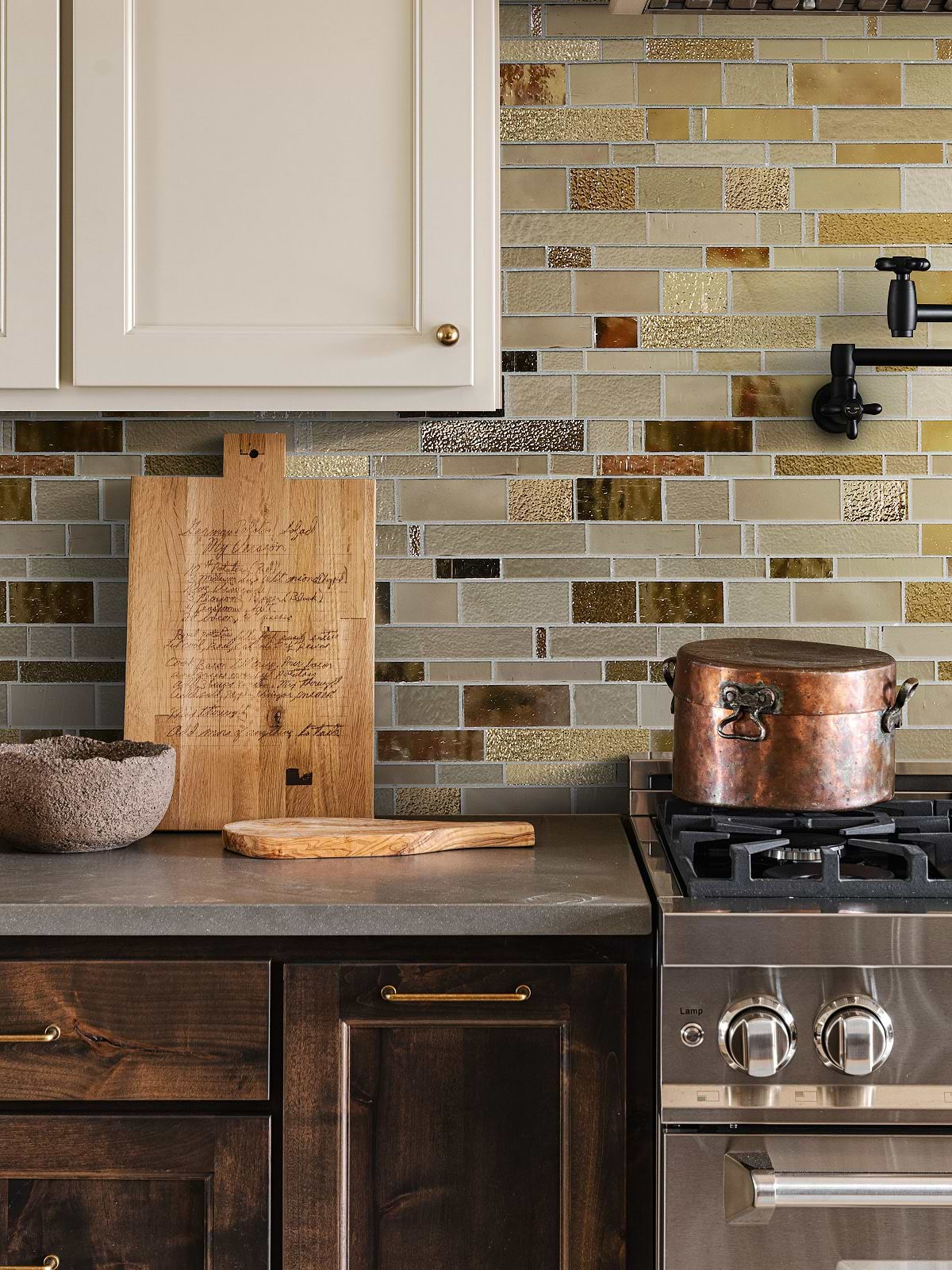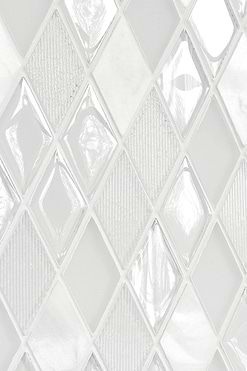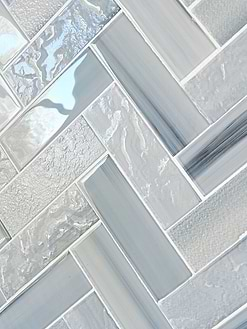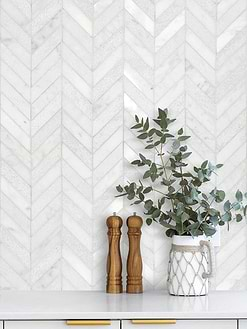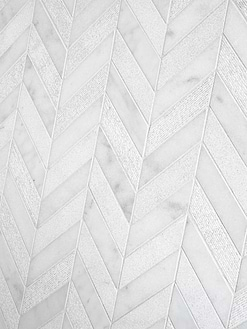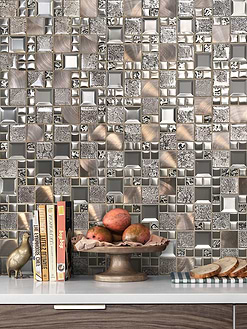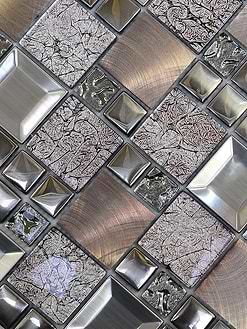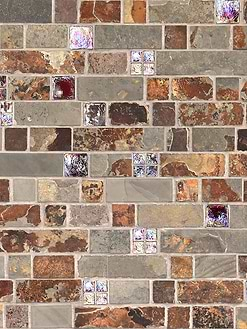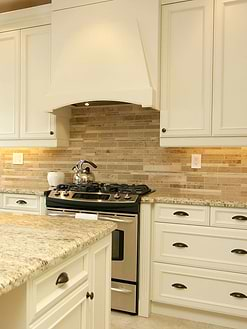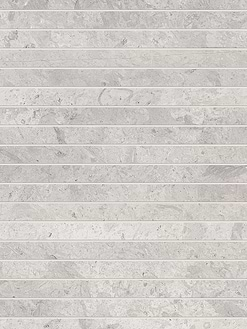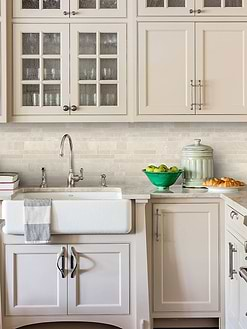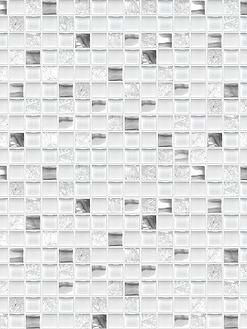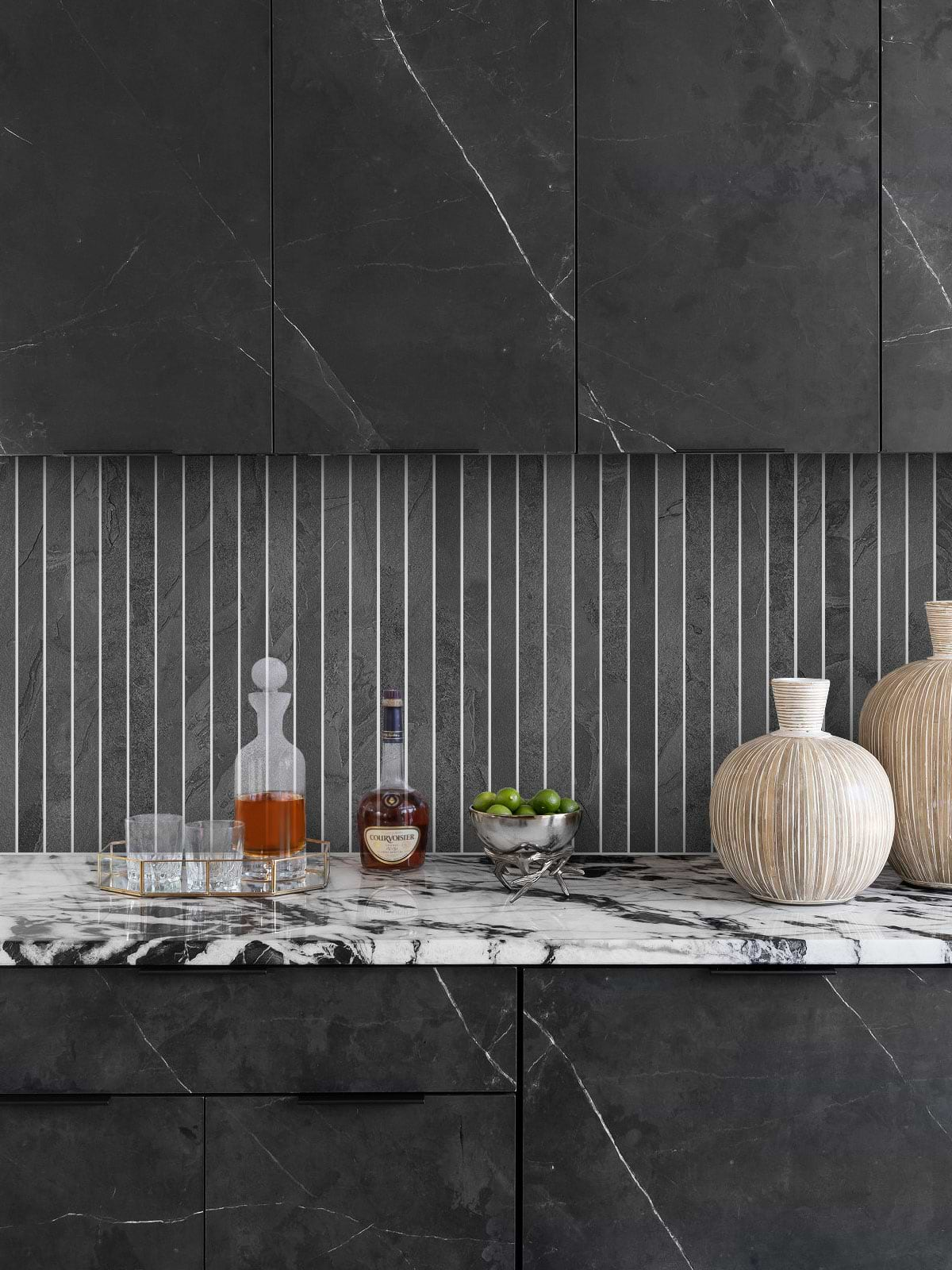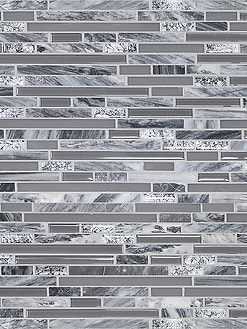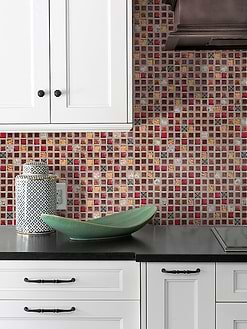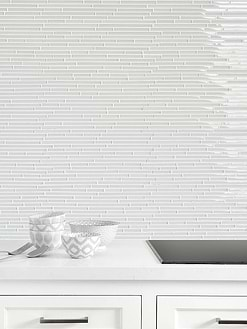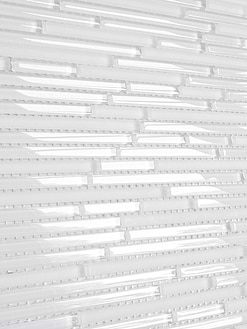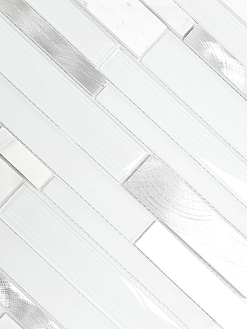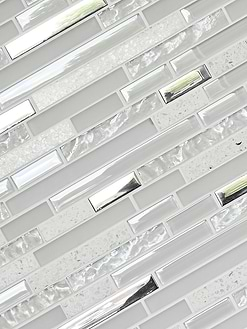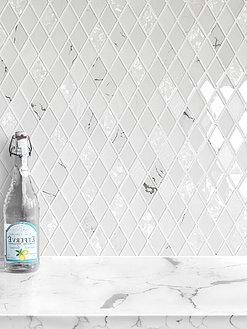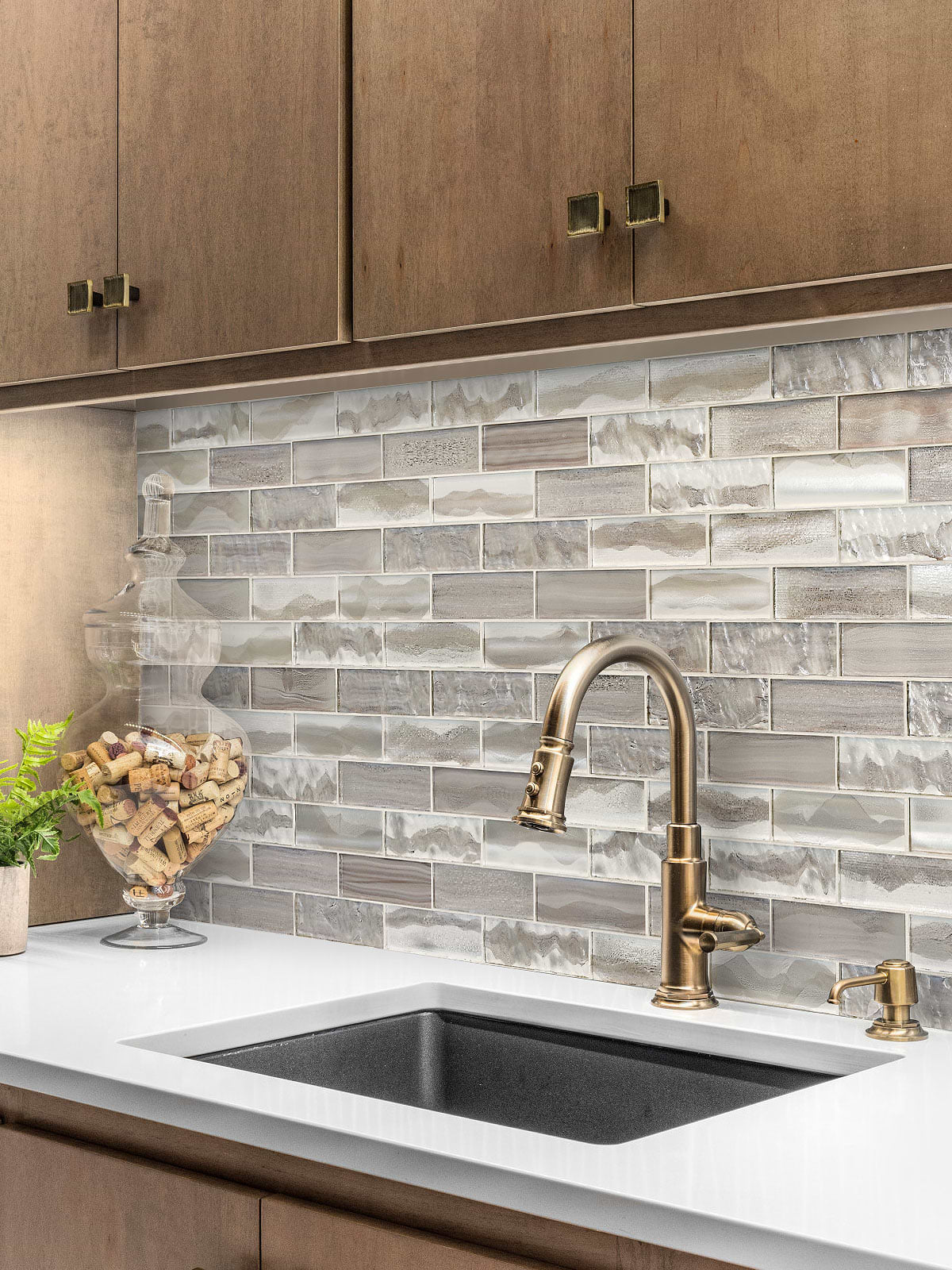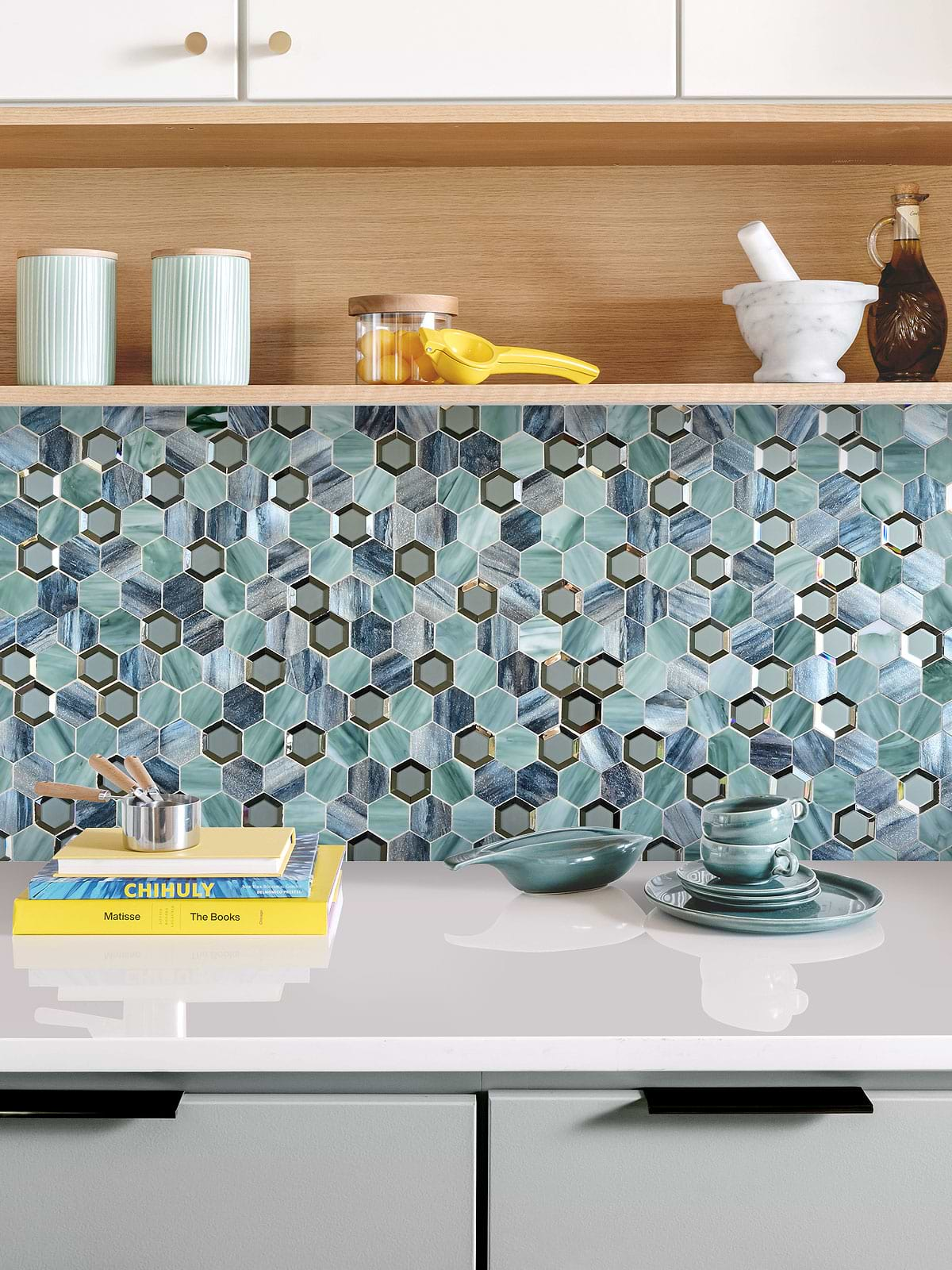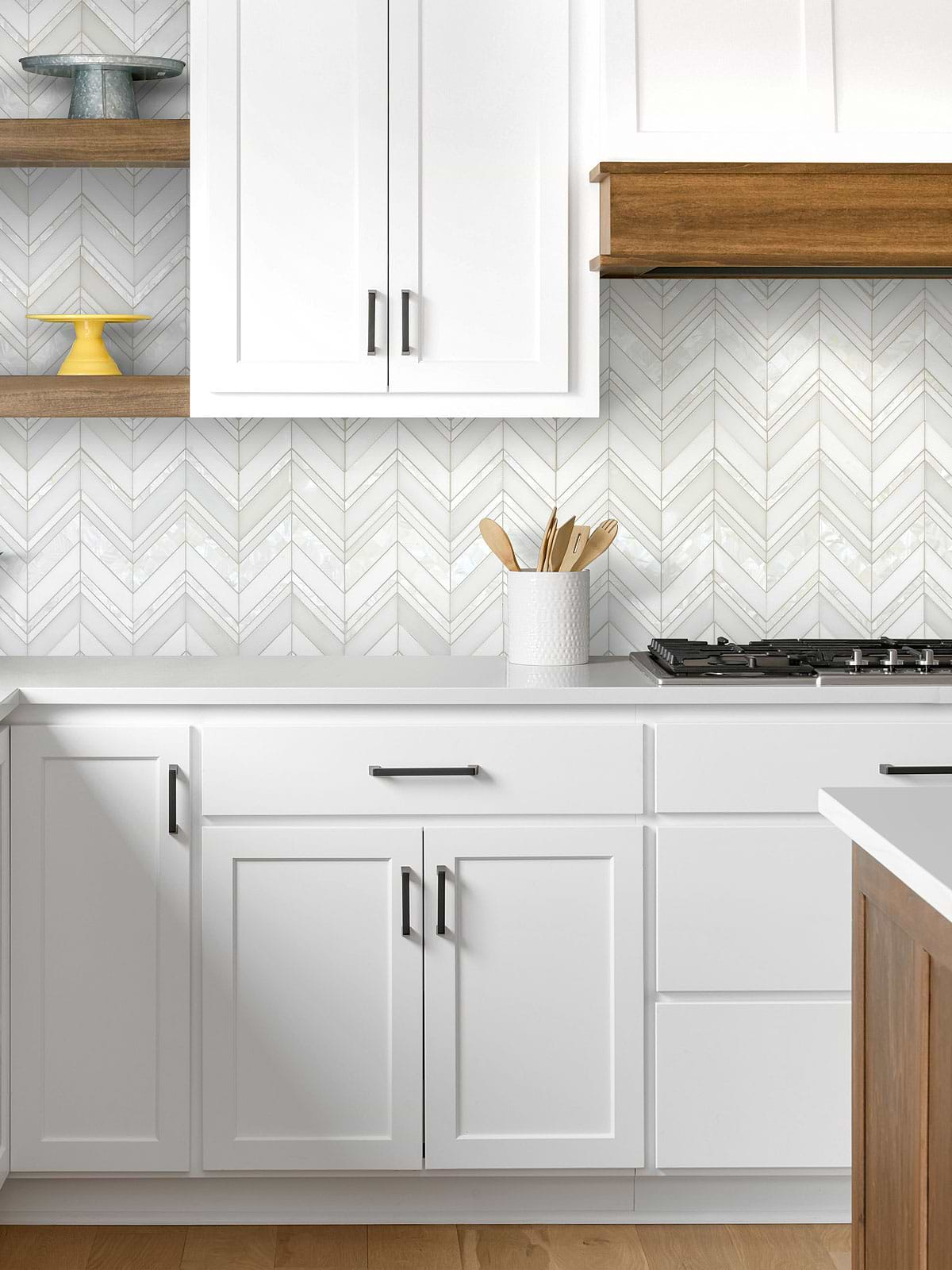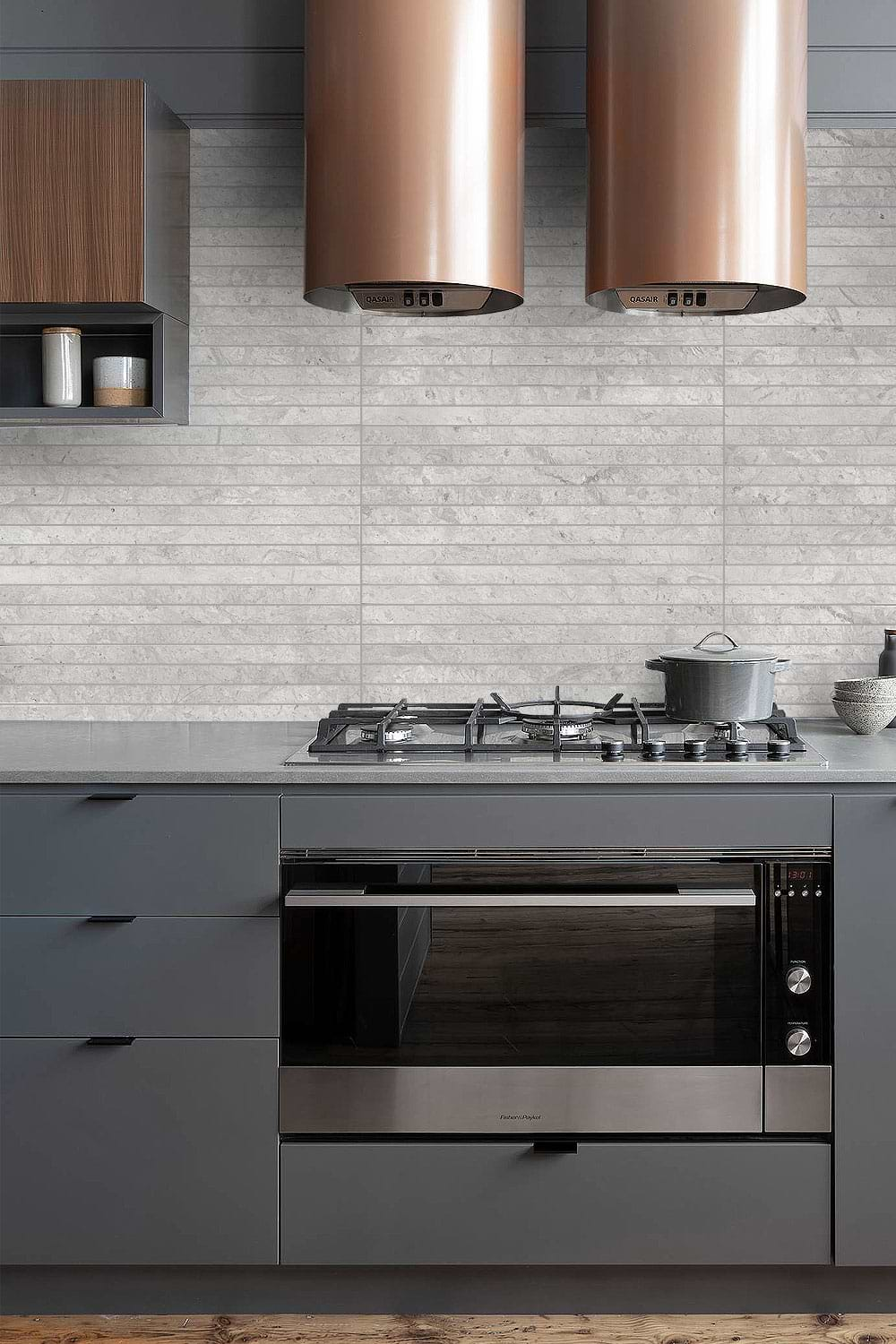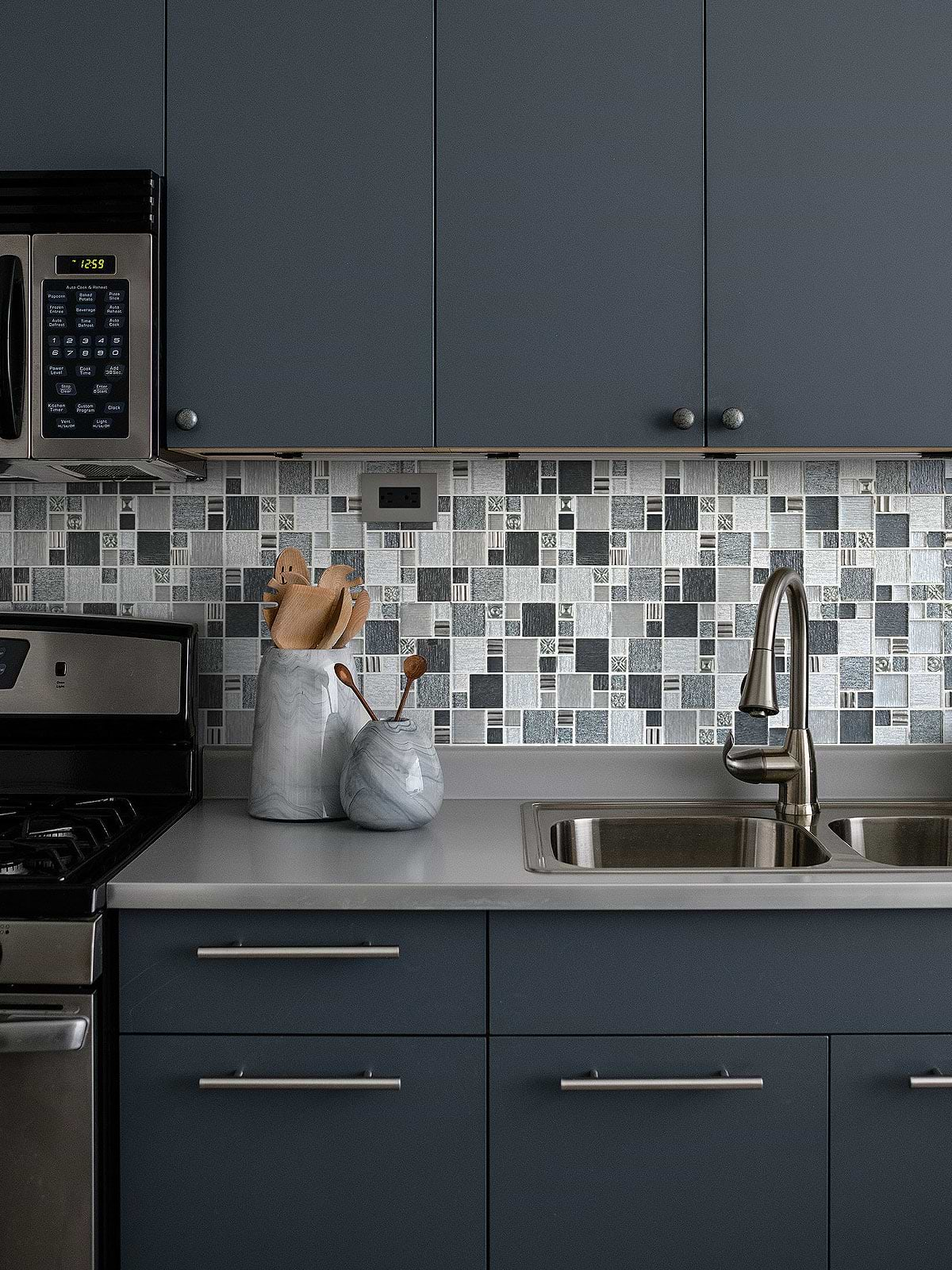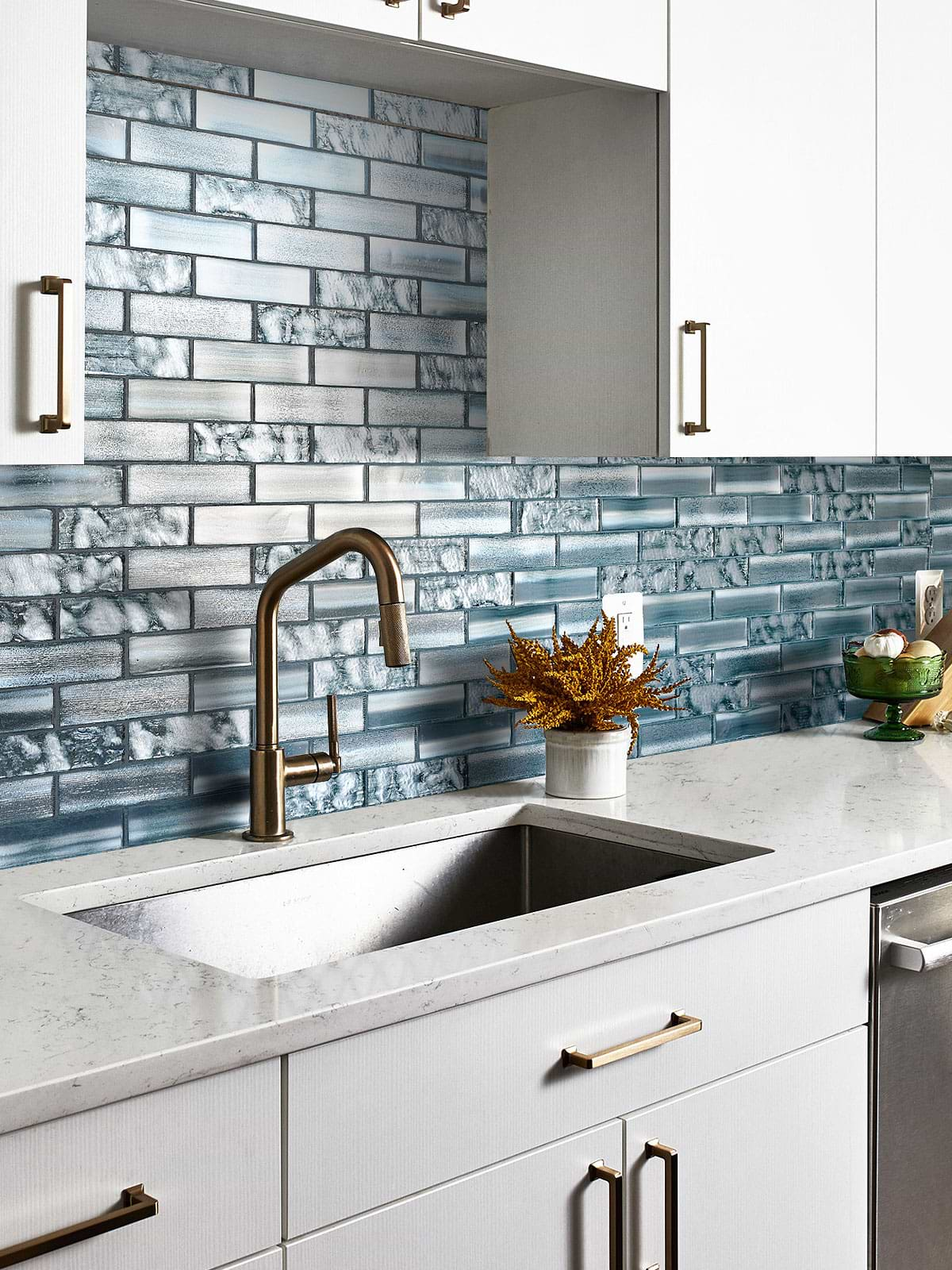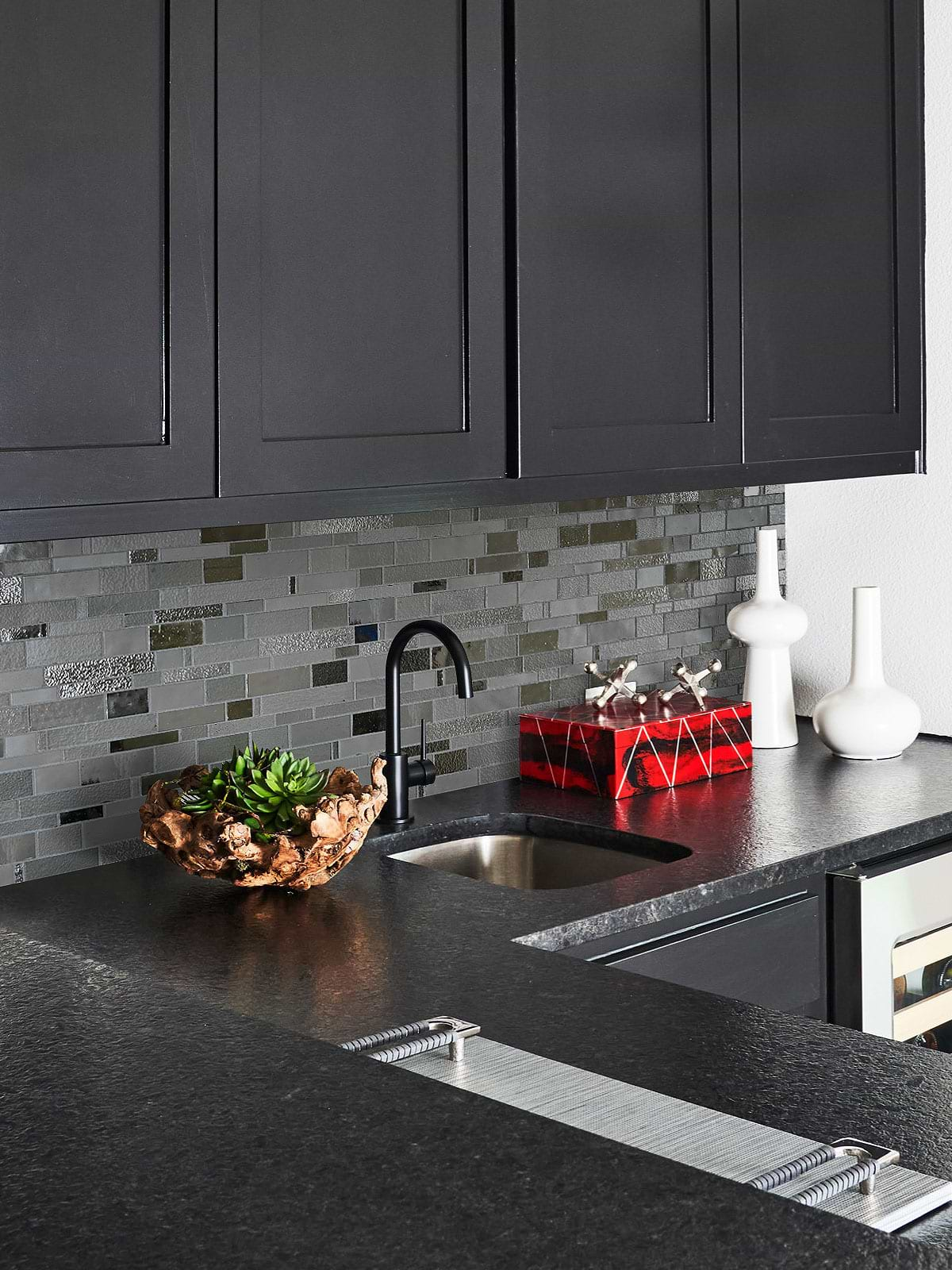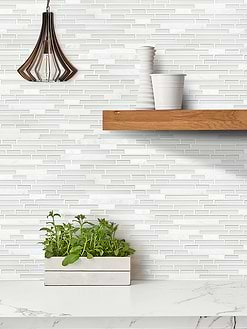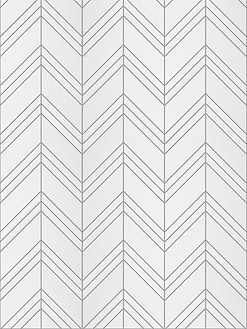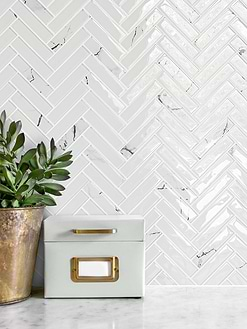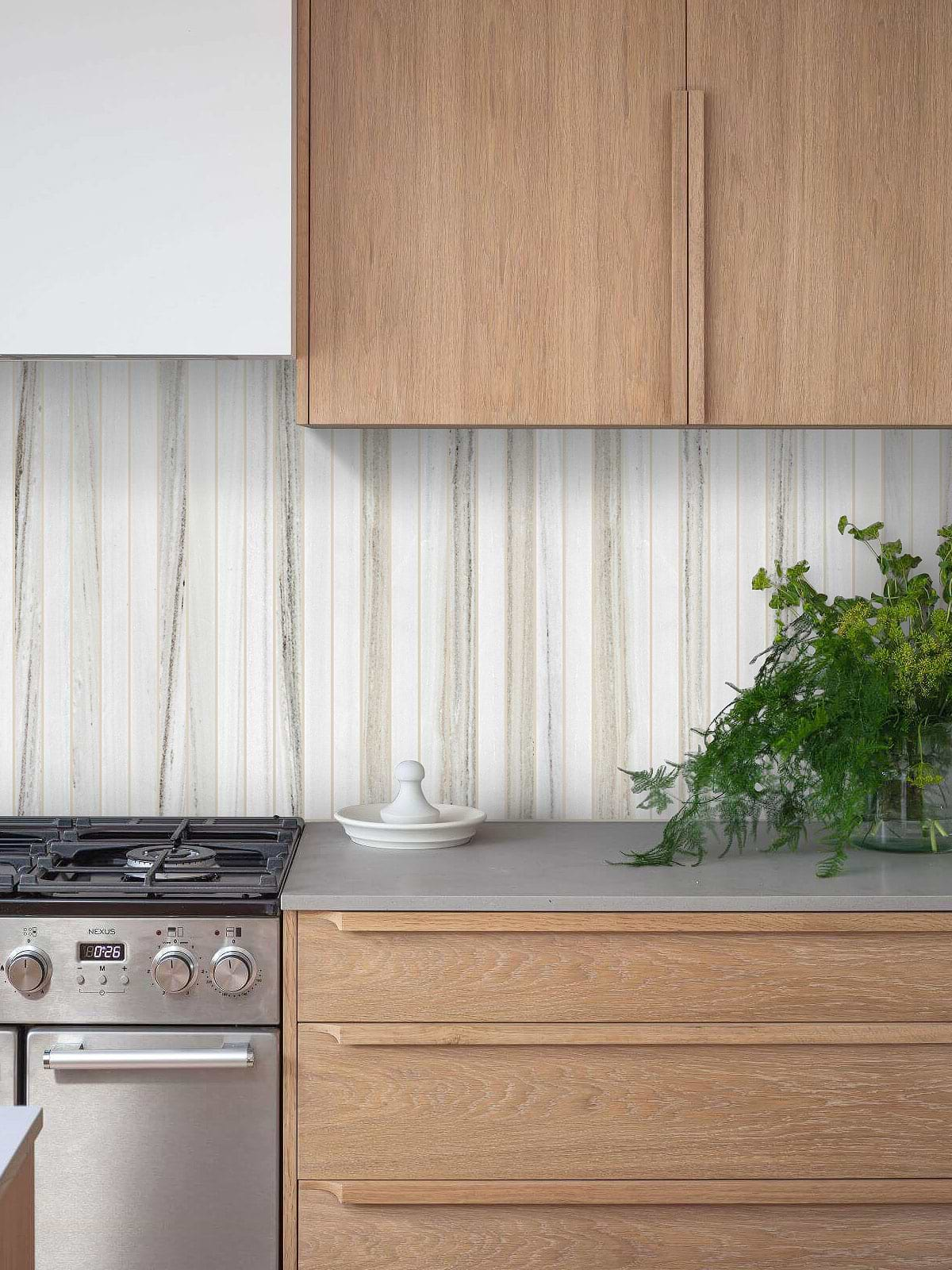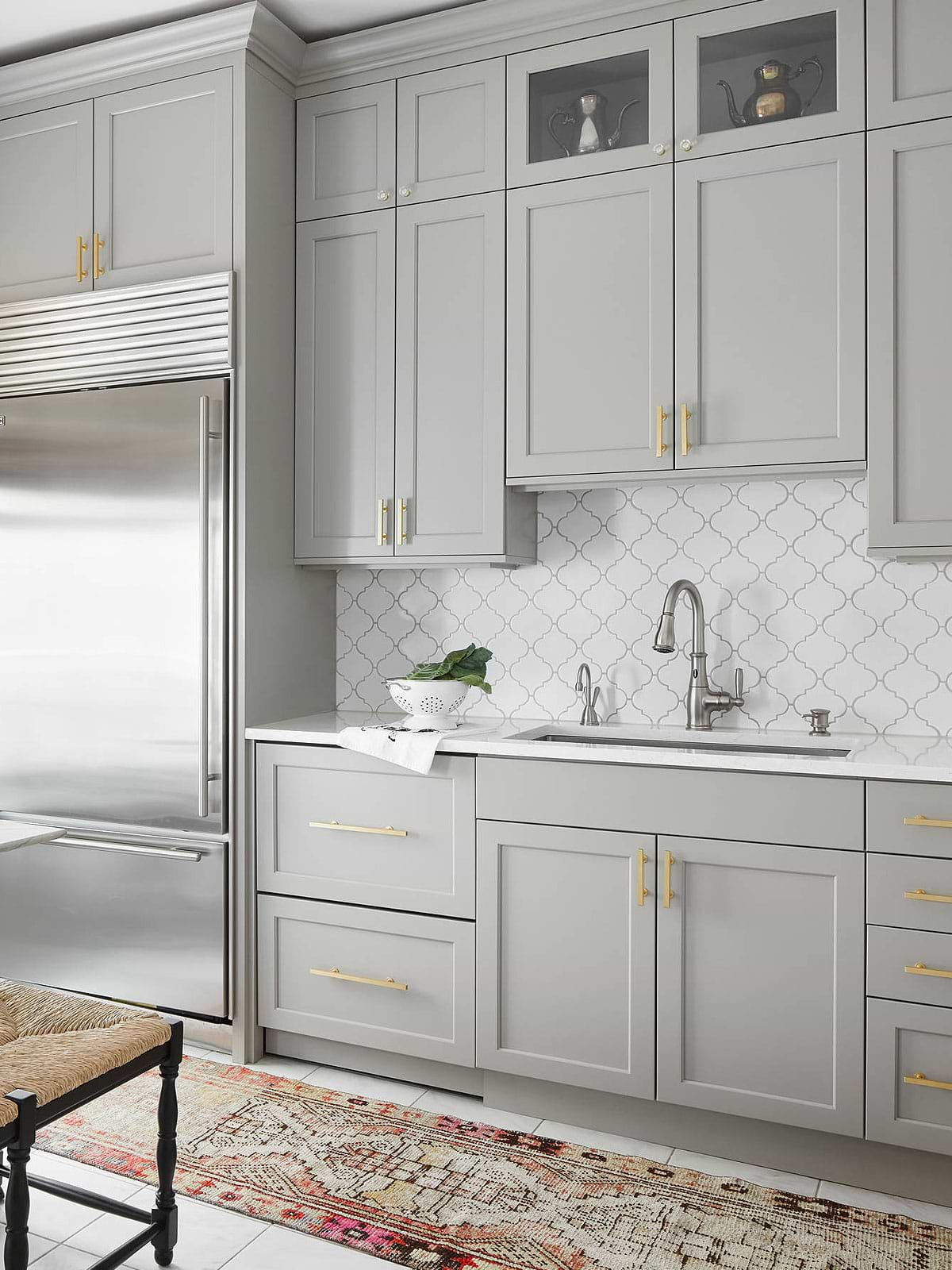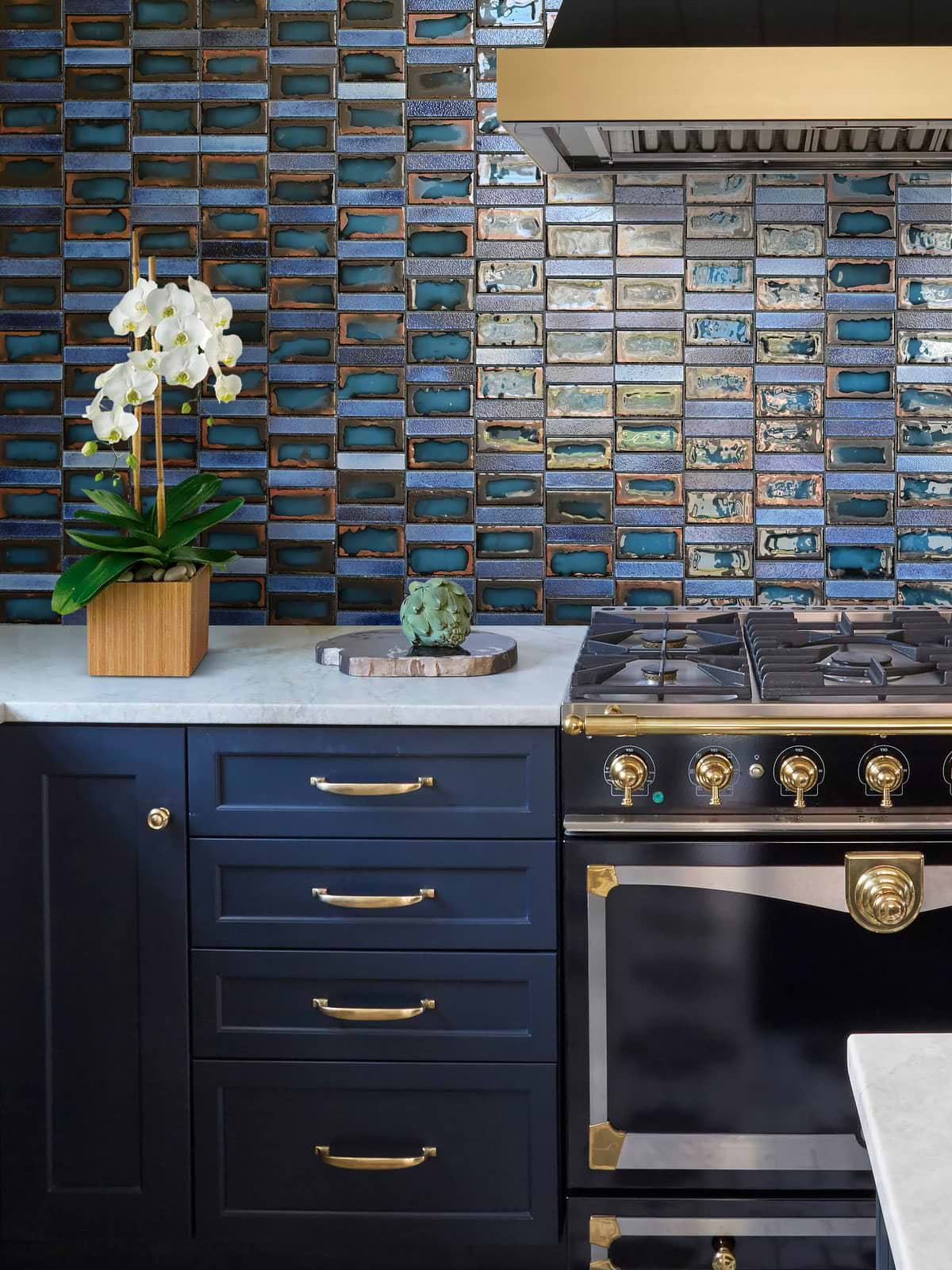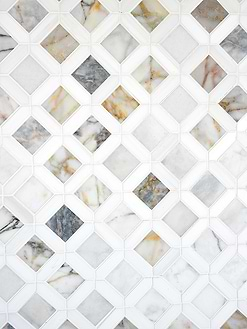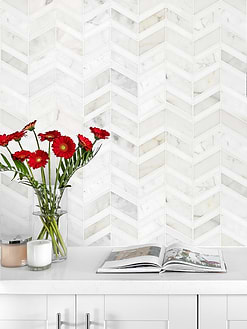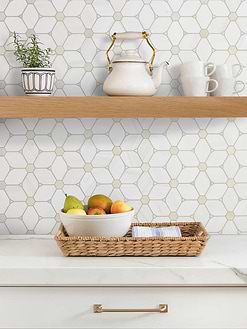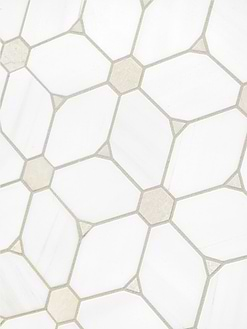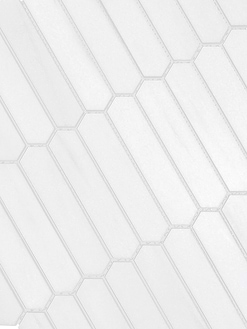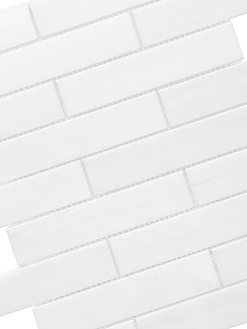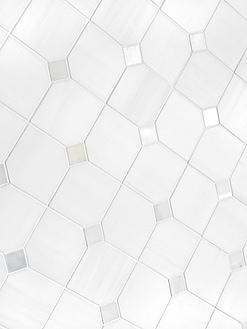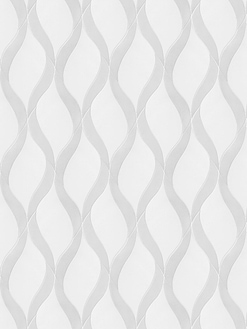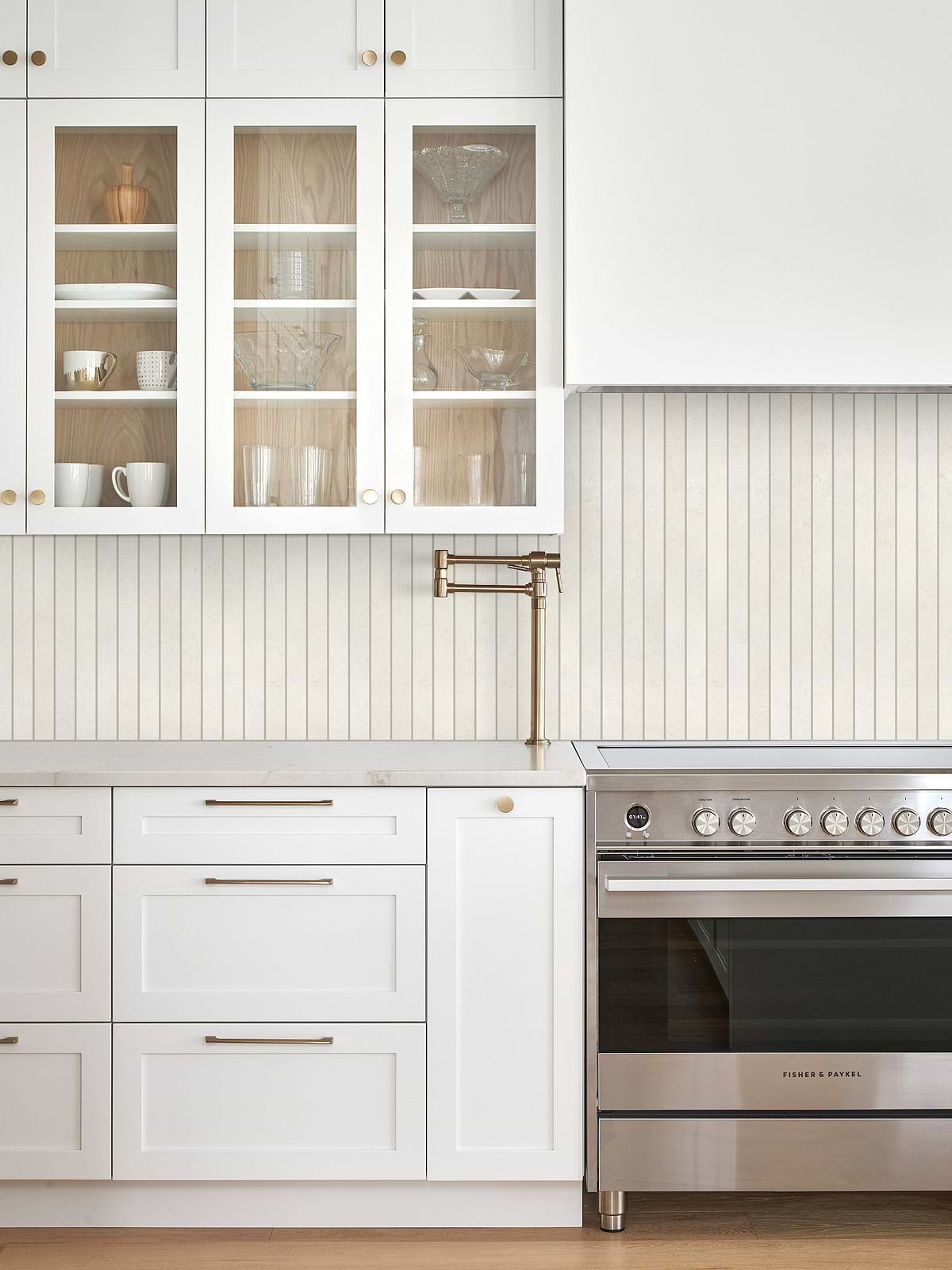18+ Sanded vs Unsanded Grout
ID# 187609 – Product BA7019 – Bronzite Brown Glass Hand Cut Artisan Mosaic Tile
Brown and White Cabinets with Glossy Mosaic Tile Backsplash
Backsplashes can make or break this one. The one that this transitional kitchen has definitely made! Used as the centerpiece of the design, it not only adds a subtle hint of sparkle but also introduces authentic forms, thanks to the irregularities in shape and size. Taking cues from Italian craftsmanship, these artisan mosaic tiles are great at executing contemporary vibes. In the rest, the white wall cabinetry just brightens up the interior while the dark brown base cabinets and gray countertops add a rustic flair.
ID# 187618 – Product BA6330 – Multicolor Marble Subway Backsplash Tile
Sanded vs Unsanded Grout for Marble Subway Backsplash Tiles
This transitional kitchen showcases that even keeping it simple gives the design enough personality. Here, the white shaker cabinets and countertops anchor the space for a bright and spacious atmosphere with a timeless appeal. It feels open, airy, and bright. The addition of the marble subway tile backsplash makes a luxurious twist that enhances the overall look. The wood trim of the range hood and brass cabinet handles complement the gold veining of the marble.
Sanded vs Unsanded Grout – Which One Is Better for Backsplash?
Backsplashes are one of the most important elements in kitchens, serving both functional and aesthetic benefits. When it comes to choosing the best tile for your backsplash, there are thousands of materials, colors, forms and sizes to choose from. Once you’ve decided on the tile type for your kitchen backsplash and even found the perfect grout color, you will need to decide which type of grout will be the right for your tile – sanded vs unsanded grout. Even if it seems like a very small detail, choosing the right type of grout is the key to finalizing the overall look and staying power of your backsplash.
What Is the Difference Between Sanded vs Unsanded Grout?
There are two main types of grout. But which one is right for your design, sanded vs unsanded grout? Both of these types have specific applications. Different factors determine whether sanded or unsanded grout is better for you, from the type of tile to the surface, you are tiling and the width of the grout lines. Since the type of grout that you will use for your kitchen backsplash can significantly affect the final finish of your project, you need to consider these several factors to find the best one for the job. However, you might get confused by all the information going on the internet. Luckily, you have come to the right place. In this article, we gather some useful tips and tricks about the difference between sanded and unsanded grout to give you a more solid idea.
ID# 187601 – Product BA631613 – Modern Gray Marble Chevron Mosaic Backsplash Tile
Two-tone Cabinets with Marble Chevron Backsplash Tiles
This coastal-inspired kitchen employs a halfway splitting color technique by dividing the kitchen into two sections by colors. While the white wall units brighten up the interior, blue base cabinets serve as an anchor for them. And in between, by contrast, the white chevron tile backsplash creates arrow-like patterns to add a contemporary flair. The metallic cabinet hardware and wood floating shelf further accentuate the design.
Best Seller Mosaic Tiles
ID# 187602 – Product BA5501 – Marble Look Blue Glass Hexagon Backsplash Tile
Sanded or Unsanded Grout for Glass Backsplash Tiles
Since glass tiles are fragile and prone to scratches, using a non-sanded grout is the safest way to achieve a proper installation. In this coastal kitchen, the blue glass hexagon tile backsplash creates a visually appealing focal point, evoking the tranquil sense of the ocean with its marble-like veins. The blue shaker cabinets create a cohesive look with the tiles while the pure white quartz countertops enlighten the atmosphere. The stainless steel appliances and matte black cabinet hardware finalize the design with a modern flair.
Do you need to seal unsanded grout on backsplash?
Even though unsanded grout is not as porous as sanded grout, it is recommended to seal it, especially for high-traffic areas like kitchen backsplashes. Sealing the unsanded grout helps prevent food, grease and other substances from penetrating the grout and causing stains. Also, a sealer can help protect the grout from moisture which is important especially if you are using it for the backsplash behind the kitchen sink. The other advantage of sealing is it provides easier-to-clean surfaces. All of these advantages expand the lifespan of your backsplash by reducing wear and tear.
ID# 187603 – Product BA1081 – Modern Black Long Slate Backsplash Tile
Black Kitchen Cabinets and Backsplash with Marble Countertops
This kitchen is like the epitome of contemporary designs. From the flat-front cabinetry to the marble countertops and vertical tile backsplash, each piece presents a decluttered form and clean look. To start with, the black kitchen cabinets taken up to the ceiling ooze sophistication as a foundation. The vertical placement of the black slate stone backsplash tiles flawlessly complements the modern design of the cabinets. The white grout lines emphasize even more this vertical layout. The marble countertops add a sense of drama with its irregular and eye-catching black veining.
Glass Mosaic Tiles
ID# 187604 – Product BA6201 – Space Brown Glass Subway Mosaic Backsplash Tile
Wood Kitchen Cabinets with White Countertops and Glass Subway Tiles
Subway tiles are classic for kitchen backsplashes, exuding timeless elegance. While white is the most popular option for these tiles, why not try a statement-maker color? As you can see in this contemporary kitchen, the glass subway tiles are adorned with a space brown color that enhances the contemporary aesthetic. The natural wood cabinets perfectly complement the warm brown hues of the tiles. This way, it creates a very sophisticated design that is cohesive and approachable all at once. The white countertops, square knobs, and brass faucet make a cohesive final touch.
What are the biggest grout mistakes?
Even if it seems like a small detail, grouting is one of the most important steps of the tile installation. That’s why there are several factors that you need to consider when it comes to the choice and application of the grout.
- Using the wrong type of grout is the most common mistake. According to the width of the grout lines, type of the tile, and the application area, you need to make a choice between the sanded and unsanded grout.
- Whether you go with sanded or unsanded grout, Using too much water makes the tile weaker and will cause the tile and grout to have an uneven color. You need to follow the manufacturer’s instructions.
- The tile adhesive takes time to cure and grouting before the adhesive has cured properly can lead to problems with adhesion of the grout.
If the application of the grout is too thin or not uniform, then it will result in weak joints or compromise the appearance of the tiles. That is why it becomes necessary to apply the grout float to press the grout to penetrate joints.
ID# 187605 – Product BA6203 – Green Glass & Metal Hexagon Mosaic Backsplash Tile
Sanded vs Unsanded Grout for Geometrical Tile Backsplashes
Geometric tile backsplashes create a statement look right away, and this one is no exception. Adorned with gorgeous green color transitions, this glass and metal hexagon mosaic tile backsplash makes a strong statement, transforming this otherwise ordinary kitchen into a stylish design. When using such a strong tile design, it is better to use a complementary grout color to avoid a busy feel. For the rest, the gray and white kitchen cabinets paired with white countertops and wood open shelves balance the striking appeal of the colorful tiles.
ID# 187606 – Product BA8030 – Chevron Pearl Marble Mosaic Backsplash Tile
Modern Farmhouse Kitchen with Wood Floor
Even if you keep the entire kitchen white- at least almost all-white a well-chosen backsplash provides enough energy to change the overall ambiance. In this modern farmhouse kitchen, for example, the white shaker cabinets and white countertops seamlessly blend with each other, creating a bright and spacious atmosphere. Between them, the marble chevron tile backsplash creates a nice textural look without breaking the freshness of the interior. The slightly darker grout colors emphasize the eye-catching chevron pattern even more. The addition of the wooden accents like the floating shelves and the trim of the paneled range hood complement the warm sense of the wood flooring. For a final touch, the black cabinet hardware enhances the modern aesthetic.
How to Choose the Right Grout Type?
When it comes to choosing the right type of grout for kitchen backsplashes, first you need to learn what is grout. Mainly, grout is a type of material that is used to fill the gaps between the tiles. Once the grout application is done, grout hardens to connect the tiles to one another. It is generally a mixture of water, cement, and sand. This application prevents water from seeping into the substrate and adds structural integrity to the backsplash. Even if it seems like a small detail, it plays a significant role and that’s why choosing the right grout requires attention to detail. To determine whether sanded or unsanded grout is best for the tile job, you need to consider several factors.
Width of the Grout Lines
When it comes to making a decision between sanded or unsanded grout, the width of the grout lines is the most important factor. Typically, sanded grout is suitable for grout lines wider than ⅛ inch. Unsanded grout, on the other hand, is used for smaller tile spacing—⅛ inch or narrower grout lines. Due to its structure, sanded grout can not properly compact into narrower grout lines. Since kitchen backsplashes generally consist of narrower joints, unsanded grout is a more proper option.
Tile Surface
Sanded grout consists of very fine quartz or silica sand which gives the grout an additional strength. However, due to its hardness, it can scratch and damage some of the materials such as glass, natural stone, or metal tiles during the installation process. That’s why it is safer and easier to work with unsanded grout for the kitchen backsplashes. Also, because sanded grout is denser and stronger, it is mostly preferred for floor applications.
Application Areas
Sanded grout is the most popular type since it can suit most applications such as floors or walls. Available in a variety of colors, sanded grout reduces grout shrinkage. For vertical tile applications such as backsplashes or shower walls, both sanded or unsanded grout can be suitable but unsanded grout will be a better option since it provides a better working material that sticks better on vertical surfaces.
ID# 187607 – Product BA1038 – Modern Long Gray Limestone Backsplash Tile
Modern Industrial Kitchen Design with A Gray Color Scheme
This modern industrial kitchen goes with an all-gray color scheme, offering a sleek and edgy look. As a foundation, the dark gray cabinets anchor the space with an elegant look. Above, the lighter gray countertops and tiles bring movement to the space. Reaching through the ceiling, the modern limestone backsplash tiles provide a sleek backdrop with a nice textural look. Though going with eye-popping rose gold circular range hoods, this kitchen knows how to maintain a sense of balance!
Can you grout a backsplash on the same day?
Even if you can apply the grout on the same day of the installation, typically it is recommended to wait 24 to 72 hours to set the tiles before applying the grout. If you grout before the adhesive has set, it can affect the adhesion of the tiles and the grout. The best way to check the manufacturer’s instructions.
ID# 187608 – Product BA8004 – Black & Gray Textured Glass Mosaic Backsplash Tile
Sanded vs Unsanded Grout for Glass Mosaic Tiles
This contemporary kitchen boasts dark gray cabinets with blue undertones that make the design look rich and opulent. But in doing so, it doesn’t sacrifice its approachability. While the lighter gray countertops complement the cabinets, the black and gray mosaic tile backsplash taps into the soul of modern designs. It takes the design to the next level with an intriguing form and busy patterns. The metallic cabinet hardware and stainless steel appliances add a quotidian life to the interior.
ID# 187610 – Product BA6202 – Space Blue Glass Subway Mosaic Backsplash Tile
Sanded vs Unsanded Grout for Glass Subway Tiles
No doubt that these glass subway tiles are a game changer. Adorned with an eye-catching space blue color, these tiles create a striking focal point for this contemporary kitchen, Even though the tiles consist of deep blue shades, their glossy finish and metallic effect avoid a heavy feel. The white flat panel cabinets and countertops provide a sleek and clean frame for the tiles and allow them to stand out even more. If you want to bring warmth out of the cool shades, one of the best ways is to use gold accents. Here, for example, the addition of the brass hardware balances the space blue color of the subway tiles, adding much-needed warmth.
Should backsplash grout be lighter or darker than tile?
Although the type of grout has relevance in the durability of the backsplash, the color of the grout makes a tremendous difference in the look of the backsplash. Still, no set rules are saying that the grout itself should be darker or even lighter in color than the actual tile material. For example, if you are using white subway tiles, you can create a subtle backdrop with white grout or emphasize the classic pattern by using a contrasting grout color. Therefore, you should ask yourself if you really want it to match the color of the tiles or if you prefer it to be a contrasting color.
ID# 187611 – Product BA7018 – Charcoal Gray Glass Hand Cut Artisan Mosaic Tile
Sanded vs Unsanded Grout for Mosaic Tile Backsplashes
This contemporary kitchen utilizes a dark color scheme, offering a rich and dramatic appeal. The black handle-free cabinets and black leathered granite countertops set the tone of the space, providing a sophisticated look. Between, the charcoal gray hand-cut mosaic tile backsplash brings a textural look and complements the dramatic flair of the black surfaces. Whether they are glass, marble, metal, or ceramic, mosaic tiles generally consist of narrow grout lines. That’s why, an unsanded grout is the best option to work with.
White Mosaic Tiles
ID# 187612 – Product BA1080 – Modern Rosewood & Gray Marble Backsplash Tile
Modern Marble Backsplash Tiles with Gray Countertops
To make a modern statement with your backsplash, go with larger tile formats. As you can see in this contemporary kitchen, the marble tiles are designed in a long and slim shape that creates a sleek modern appeal as a backdrop. The rosewood and gray veining of the marble stone is complemented by the natural wood kitchen cabinets and gray quartz countertops. The beige grout color of the tiles creates a cohesive look with these veining. The final accents are made by the stainless steel stove, the white range hood, and wooden handles that give the necessary note of the modernist direction.
Sanded Grout
Containing sand mixed with cement and other ingredients, sanded grout is a default choice for tiling applications that can be used for both flooring and walls. It is generally less expensive than unsanded grout because sand is cheap and it forms the bulk of sanded tile grout. Due to its hard and dense structure, sanded grout resists cracking, making it suitable for wider grout joints wider than 1/8 inch. That’s why it is mostly used for areas where durability is important such as flooring. Sanded grout requires sealing to prevent water damage, due to its porous texture.
The width of the grout joints is one of the most important factors that determines the usage of sanded or unsanded grout. Sanded grout is suitable for grout joints that are 1/8 inch wide or wider because it is more difficult to insert it into narrow grout lines. While this dimension is generally used for floor applications, you can also use it for the backsplashes. However, since the sanded grout can scratch some of the materials like glass, metal, or natural stone, unsanded grout will be a better option if you use these materials for your backsplash. Aside from its functional aspects, sanded grout also comes in a wide range of color options that allow you to create a cohesive look with your tiles.
ID# 187613 – Product BA310131 – White Porcelain Arabesque Backsplash Tile
Sanded vs Unsanded Grout for Porcelain Tiles
This transitional kitchen keeps things simple and makes differences with small details. To start with, the gray cabinets anchor the space and provide a sleek and sophisticated foundation. Their ceiling height layout provides ample storage for kitchen essentials. The white arabesque tile backsplash creates a nice textural look that enhances the traditional charm. Even though sanded grout can be used for the matte porcelain tiles, these arabesque tiles have 1/8 inch grout lines which means a non-sanded grout will be a better option. The white countertops create a continuous look with the tiles. The addition of the brass hardware and Turkish runner gives the space a more lived-in feel.
Is unsanded grout easier or harder to clean than sanded grout?
In general, unsanded grout is easier to clean than sanded grout. Unsanded grout has a smooth finish, hence it does not form a rough surface that tends to accumulate dirt when cleaning, unlike sanded grout.
ID# 187614 – Product BA6204 – Blue Rustic Glass & Ceramic Mosaic Backsplash Tile
Navy Blue Cabinets with ceiling-height backsplash
It is hard to decide whether the blue backsplash tiles or the black kitchen appliances demand more attention in this contemporary kitchen! Here, the blue backsplash tiles, with their glossy appeal and ceiling-height layout, create an eye-catching backdrop, making a dramatic statement. The navy blue cabinets complement this dramatic appeal while the white Silestone quartz countertops enlighten the atmosphere. The black kitchen appliances adorned with gold details bring a vintage flair to the design.
Marble Mosaic Tiles
ID# 187615 – Product BA4501 – Modern Long Beige Porcelain Backsplash Tile
White Shaker-style Cabinets with Beige Backsplash Tiles
This one-wall kitchen is characterized by white shaker cabinets that lend ultra-brightness to the space. The glass-fronted doors of the upper cabinets give the space a light and airy feel. The light beige color of the porcelain tile backsplash and light gray countertops just spices up this all-white look without feeling over the top. The wood flooring delivers an instant warmth, while the brass cabinet hardware complements this warm sense with a dose of sparkle.
Unsanded Grout
Unsanded grout is another type of grout that is used for tile applications. The main difference between the sanded and unsanded grout is their compositions. While sanded grout contains sand mixed with cement and other ingredients, unsanded grout is made from cement and water only, with no sand. The absence of sand provides a smoother texture and consistency and makes it easier to apply in tight spaces.
The denser and thicker structure of the sanded grout makes it difficult to work into narrow grout joints. Since backsplashes generally contain 1/8 inch wide or very thin grout lines, unsanded grout is a better option to work with. Also, the absence of sand makes it less abrasive and won’t scratch the surface of delicate tiles. That is why it can be used for even delicate tile surfaces like glass or natural stone. The usage of polymers instead of sand for the unsanded grout makes it stickier than sanded grout. This structure helps it stay better in vertical grout lines and achieve great results for backsplash installations.
ID# 187616 – Product BA8001 – Sparkled White Glass Subway Backsplash Tile
White Subway Tile Backsplash with White Grout
To match the timeless beauty of the subway tiles, this transitional kitchen sticks to a basic white color palette without being ordinary. To start with, the white shaker cabinets draw a classic profile that will never go out of style. The white quartz countertops complement the slight marble textures on the glass subway tiles to create a continuous look. The white grout lines complete the brightness of the tiles providing a subtle backdrop. The brass knobs are the only elements that break the white color scheme and add much needed warmth.
How to grout backsplash tile?
Once you have installed your backsplash tiles, grouting is the next step. The materials that you need;
- Grout (sanded or unsanded, depending on the grout line width)
- Grout float
- Sponge
- Bucket with water
- Clean rags or towels
- Grout sealer
First, start by preparing the grout. Mix the dry grout with water in a bucket by following the manufacturer’s instructions. At this point, you require a groat float and have to spread grout with the float at a forty-five-degree angle. To do this, it is better to apply it in a diagonal direction to guarantee that the grout penetrates into the joints successfully. Once all the joints are filled with the grout, make sure to remove all the remaining grout before it hardens.
Following the application of the grout, there is a certain period that must be accorded to allow the grout to cure. Usually, it is 20-30 minutes. Then by using a damp sponge, you should start to wash the tiles in circles to make sure you don’t miss any spots. Lastly, seal the grout with a proper grout sealer. Before starting using it, wait for 2-3 days for the backsplash tiles to rest and cure completely.
ID# 187617 – Product BA7015 – Opal Beige Glass Hand Cut Artisan Mosaic Tile
Natural Wood Cabinets with Black Countertops and Glossy Tiles
This contemporary kitchen has a way of delivering a contrasting scheme without making it too stark. The natural wood cabinets set a warm and welcoming tone for the kitchen atmosphere. The brass cabinet hardware creates a cohesive look with the cabinets, adding a dose of sparkle. Reaching through the cabinets, the beige hand-cut artisan mosaic tile backsplash, with its glossy finish, keeps the interior lightened up. Between them, the black countertops bring a striking contrast that enhances the overall aesthetic.

